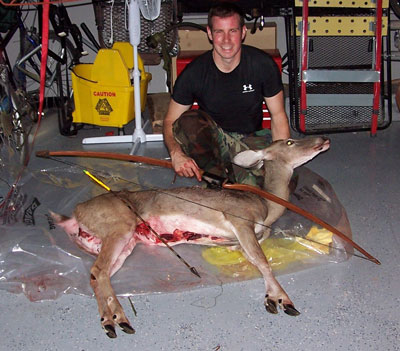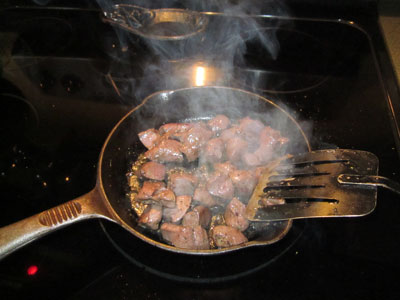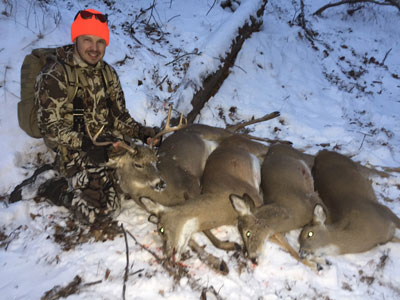Hunting Chicken - Oct/Nov 2018
Sliding through an opening in the
underbrush with his delicate longbow and well-worn back quiver, the hunter
eased into a clearing as he scanned his new surroundings with silent and
determined intent. The dense and humid
air caused a trickle of sweat to roll down from his sideburns as the buzz of
mosquitoes and gnats hovered annoyingly around his head and eyes. Out of the
periphery of his vision, he caught a glimpse of something that triggered an
immediate stimulus and endorphin rush.
Nestled along a log in the distance was not a deer, but there was an
imminent harvest nonetheless.
Numerous seasoned woodsman know
about spring Morel mushrooms, but there is another delicacy that is almost as
easy to identify, widely available throughout late spring and into hunting
season in most parts, and is a delicious wild forage of the gourmet
caliber. The fungi in question is Laetiporus Sulphureus, or known more
commonly as “Chicken of the Woods”.
I came to know this mushroom quite
by accident. While attending a large traditional shoot in May of 2012, I posted a photo on a traditional archery
forum of a big bright rosette of mushroom shelves I spotted growing near a log
on the course that I thought was interesting.
I was amazed when a fellow brother of the bow asked if I had eaten it.
I was never one who was very fond
of eating mushrooms in general, though I have recently become enamored with the
reclusive spring morel, and now the Chicken of the woods. There are several reasons for this recent
affinity for these two forest treasures. The major factor is that both have a
meaty flavor. You probably guessed that
chicken of the woods mushrooms tastes a bit like chicken to most. The morel also having a meaty and earthy
flavor.
Another aspect that is also appealing
to me is the ease in identification. It
is difficult to misidentify these for their potentially toxic relatives. Chicken are shelf brackets that are
characterized by a bright orange or sulphur-yellow colored body often with bright
yellow tips. There fleshy and rubbery
bodies usually have yellowish pores on whitish undersides that have no
gills. They have an affinity to grow on
Oak, though they can also be found on beach, chestnut, willow, yew and
sometimes even coniferous tree species. Their bright overlapping fan shaped
caps can be quite large, some brackets can weigh over 100 pounds, and visible
from quite a distance.
Some individuals have a sensitivity
to this species, and fewer still can have a full out allergic reaction. It is
wise to eat a very small amount your first time to see if you react. Use caution if you already have a wood
allergy or if the host tree is known to have irritating or toxic qualities like
the yew tree. The edible quality can
also vary with the age of the organism, so don’t give up on them if your first
culinary experiment was not fantastic.
You may have just had a bad batch.
If you are lucky enough to come
across a good fresh batch it will be very moist, brightly colored, and rubbery
throughout. The entire bracket is
delicious. If the growth is older, the
thicker base will be woody and only the fringe will be choice. It has been said that if only the edges are
harvested, the brackets will continue to grow and allow multiple harvests in
the same season.
Once collected, they can be
immediately soaked in salt water to remove any insects and prepared. To preserve them, dehydration does not work
well. The thick bodies do not re-hydrate
very well. I prefer to freeze them by
layering between waxed paper on a sheet pan until they are solid. This keeps them from sticking together. I’ll place the frozen brackets in a bag and
then remove a few at a time for meals while keeping the rest frozen. They will last in excess of a year this way
and longer if you vacuum seal.
Once soaked and rinsed to remove
any insects or debris, you can cook them like chicken breast. I have had success breading and frying,
sautéing in butter with onions (maybe with perogies), adding to stews, and of
course my favorite authentic German Jaeger Schnitzel (hunters Schnitzel; recipe
below).
I have come to enjoy and take great
satisfaction in harvesting some of the many offerings that the woods
provide. Many wild foods such as
berries, fruits, and mushrooms are available during the times when we are in
the field hunting. Keeping an eye out
for these morsels can add a bit of
excitement to any hunt, and you might feel good at being a little bit more
self-sufficient.
Jaeger Schnitzel
Ingredients:
½ pound of Venison chops (5 or 6 x
1 inch backstrap chops)
1 cup of sliced Chicken of the
woods mushroom
1/3 cup sliced morel mushrooms
1 cup of all-purpose flour
1 cup of Italian breadcrumbs
1/4 teaspoon of salt
¼ teaspoon of black pepper
3 tablespoons of olive oil
3 tablespoons of butter
½ a sweet onion or one large
shallot
¼ cup of red wine
½ cup of beef stock or broth
2 eggs
¼ cup of heavy cream (or whole milk)
Place your venison cutlets between
2 layers of cling wrap (to keep things from splattering) and pound each side
with a meat hammer to tenderize.
Dredge the pounded cutlets in a
plate of flour salt and pepper, then coat in a bowl with the well beaten
eggs. Transfer the cutlets then to a
plate with the Italian breadcrumbs and thoroughly coat. Reserve some of the
flour for thickening later.
Heat a large heavy cast iron
skillet with the olive oil and butter over medium -high heat. In batches, cook
venison 3-4 minutes, or until browned, turning once. Remove the venison from
pan; set aside and keep warm.
Using the same pan used for the
cutlets, add the thinly sliced onion or shallot, and the mushrooms and sauté 3-4
minutes adding additional butter if necessary and salt and pepper, until
tender.
Add the wine and beef stock and
bring to a boil for several minutes.
Add the heavy cream or milk and
about a teaspoon of flour to thicken sauce to the consistency of gravy while
constantly stirring.
To serve pour the mushroom sauce
over the cutlets and enjoy with an accompaniment of traditional German
Spaetzle, butter noodles, or potato of your choice.




















